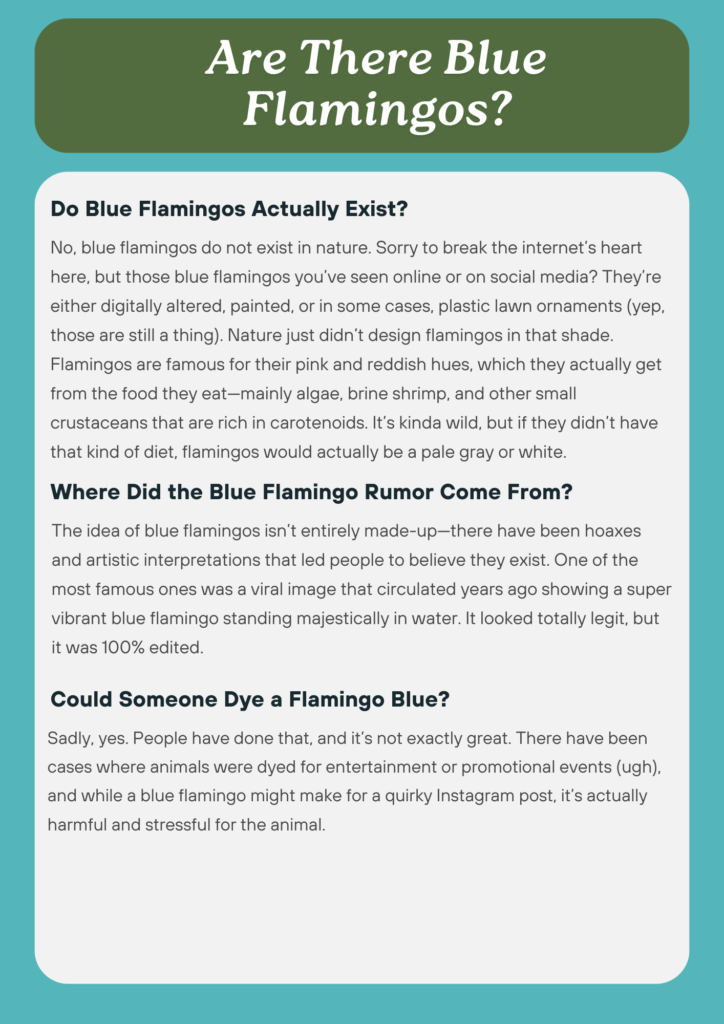Okay, real talk—are there blue flamingos? It’s one of those random questions that might pop into your head at 2 AM while you’re deep in some internet rabbit hole or watching a weird animal documentary. I mean, we’ve all seen those striking pink flamingos standing on one leg like yoga masters, but blue ones? That sounds… kinda magical, right? Or like something out of a cartoon or a video game. But here’s the thing: the internet is filled with rumors and photoshopped images, so let’s actually dig into whether blue flamingos are real or just another colorful myth that’s floating around out there.
So, Do Blue Flamingos Actually Exist?
The short answer? No, blue flamingos do not exist in nature. Sorry to break the internet’s heart here, but those blue flamingos you’ve seen online or on social media? They’re either digitally altered, painted, or in some cases, plastic lawn ornaments (yep, those are still a thing). Nature just didn’t design flamingos in that shade.
Flamingos are famous for their pink and reddish hues, which they actually get from the food they eat—mainly algae, brine shrimp, and other small crustaceans that are rich in carotenoids. It’s kinda wild, but if they didn’t have that kind of diet, flamingos would actually be a pale gray or white. So if nature had wanted blue flamingos, I guess the shrimp would need to come with a side of blueberries or something!
Where Did the Blue Flamingo Rumor Come From?
Okay, here’s where it gets a little weird. The idea of blue flamingos isn’t entirely made-up—there have been hoaxes and artistic interpretations that led people to believe they exist. One of the most famous ones was a viral image that circulated years ago showing a super vibrant blue flamingo standing majestically in water. It looked totally legit, but it was 100% edited.
Some pranksters even claimed these so-called blue flamingos were from the “Galápagos” or some mysterious, untouched island no one had heard of. Others said they were extremely rare and only appeared once every hundred years (seriously?). It’s the kind of stuff that sounds cool, but falls apart the second you Google it or ask, like, literally any zoologist.
But Wait… Could They Technically Turn Blue?
Alright, let’s geek out a little bit here. In theory—and this is very much a theory—if flamingos were to consume large amounts of blue-pigmented food, like certain spirulina algae (which can be blue-green), maybe their color could shift slightly. But we’re talking “maybe a bit duller pink or grayish,” not electric blue or royal blue like some pictures suggest.
Also, flamingo pigmentation isn’t just a “mix and match” paint set. Their feathers, beaks, and even legs are affected by long-term diet and how their bodies process carotenoids. Blue pigments, like phycocyanin found in some algae, just don’t have the same impact on bird coloration.
So while it’s kinda fun to imagine flamingos changing color like mood rings, that’s not how biology works. Sorry, nature has rules, even if the internet doesn’t.

Are There Any Birds That Are Blue?
Yes! Tons, actually. Blue is a super common color in the bird world. You’ve got blue jays, indigo buntings, bluebirds, hyacinth macaws, and even the brilliantly blue peacock if you want to get fancy. But the interesting thing? That blue color in most birds isn’t actually due to pigment like in flamingos—it’s from the structure of their feathers. Yep, it’s all about how light reflects off the microscopic structure of their feathers, not what they eat. Wild, right?
So, while you won’t find blue flamingos waddling around anywhere, you’ve still got plenty of genuinely blue birds to admire—just not standing on one leg in a swamp.
Could Someone Dye a Flamingo Blue?
Sadly, yes. People have done that, and it’s not exactly great. There have been cases where animals were dyed for entertainment or promotional events (ugh), and while a blue flamingo might make for a quirky Instagram post, it’s actually harmful and stressful for the animal. Flamingos have delicate skin and feathers, and exposing them to dye can lead to irritation, sickness, or even worse. So if you ever see a real flamingo that’s somehow bright blue? That’s not nature—it’s probably animal cruelty, and it ain’t cute.
So Why Are Flamingos Pink in the First Place?
Quick recap! Flamingos are pink because of carotenoids, which are pigments found in the crustaceans and algae they eat. It’s kinda like how eating too many carrots can tint your skin orange (that’s not a myth, by the way—it’s real!). Baby flamingos are actually born gray or white, and they only turn pink after months of eating all that carotenoid-rich food. Wild, right?
Conclusion
Alright, so let’s circle back to that big question: Are there blue flamingos? Nope. Not naturally, not in the wild, and not in any scientific records. The ones you might’ve seen online are either fake, altered, or straight-up hoaxes. Flamingos are already fabulous in pink, so let’s just appreciate them as they are. And if you really need a blue bird fix, go hang out with a blue jay or check out a peacock in full strut.
Still, it’s kinda fun to imagine a flock of blue flamingos chilling in some tropical lagoon, huh? Maybe in an alternate universe—or your next Photoshop project.

